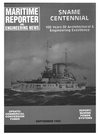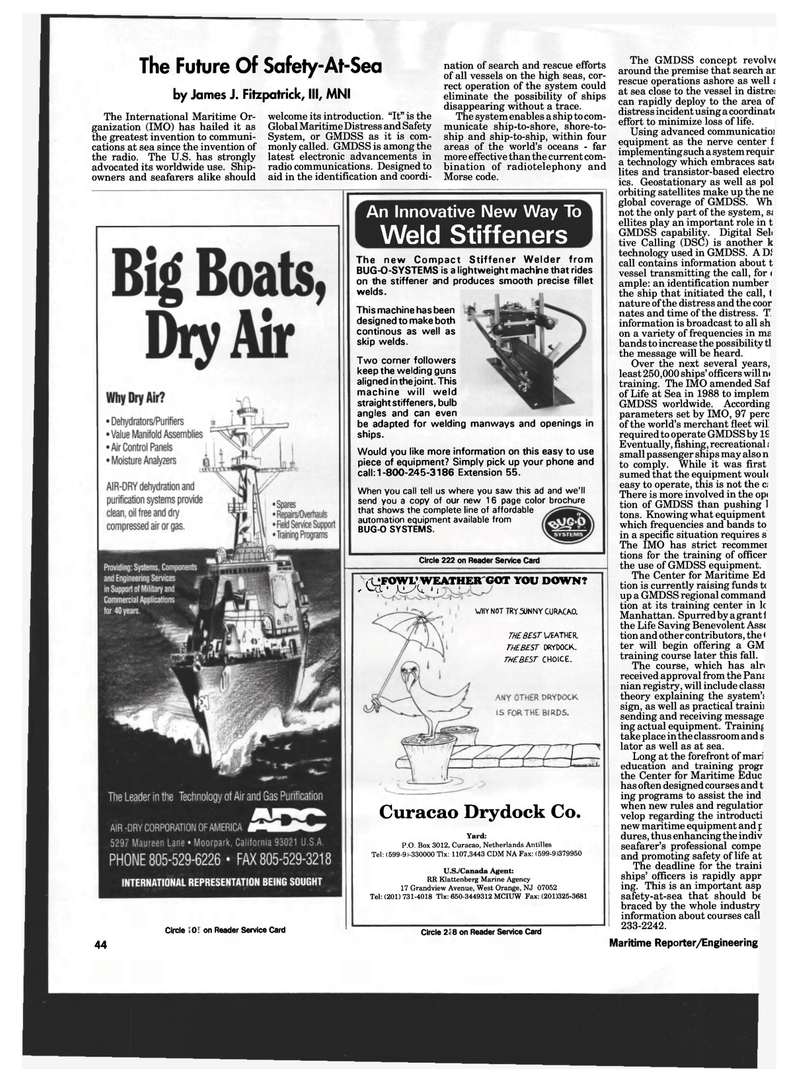
Page 42: of Maritime Reporter Magazine (September 1993)
Read this page in Pdf, Flash or Html5 edition of September 1993 Maritime Reporter Magazine
The Future Of Safety-At-Sea by James J. Fitzpatrick, III, MNI
The International Maritime Or- ganization (IMO) has hailed it as the greatest invention to communi- cations at sea since the invention of the radio. The U.S. has strongly advocated its worldwide use. Ship- owners and seafarers alike should welcome its introduction. "It" is the
Global Maritime Distress and Safety
System, or GMDSS as it is com- monly called. GMDSS is among the latest electronic advancements in radio communications. Designed to aid in the identification and coordi- nation of search and rescue efforts of all vessels on the high seas, cor- rect operation of the system could eliminate the possibility of ships disappearing without a trace.
The system enables a ship to com- municate ship-to-shore, shore-to- ship and ship-to-ship, within four areas of the world's oceans - far more effective than the current com- bination of radiotelephony and
Morse code.
An Innovative New Way To
Weld Stiffeners
The new Compact Stiffener Welder from
BUG-O-SYSTEMS is a lightweight machine that rides on the stiffener and produces smooth precise fillet welds.
This machine has been designed to make both continous as well as skip welds.
Two corner followers keep the welding guns aligned in the joint. This machine will weld straight stiffeners, bulb angles and can even be adapted for welding manways and openings in ships.
Would you like more information on this easy to use piece of equipment? Simply pick up your phone and call: 1-800-245-3186 Extension 55.
When you call tell us where you saw this ad and we'll send you a copy of our new 16 page color brochure that shows the complete line of affordable automation equipment available from
BUG-0 SYSTEMS.
Circle 222 on Reader Service Card
Circle 303 on Reader Service Card ( JFOWL'WEATHER GOT YOU DOWN? ' • xiy^ 11
WHY NOT TRY5UNNY CURACAO.
THE BEST U/EATHER.
THEBEST DRY DOCK..
THEBEST CHOICE.
Curacao Drydock Co.
Yard:
P.O. Box 3012. Curacao, Netherlands Antilles
Tel: (599-91-330000 Tlx: 1107,3443 CDM NA Fax: (599-9)379950
U.S./Canada Agent:
RR Klattenberg Marine Agency 17 Grandview Avenue, West Orange, NJ 07052
Tel: (201) 731-4018 Tlx: 650-3449312 MCIUW Fax: (201)325-3681
Circle 287 on Reader Service Card 44
The GMDSS concept revolv< around the premise that search ar rescue operations ashore as well i at sea close to the vessel in distrei can rapidly deploy to the area of distress incident using a coordinat* effort to minimize loss of life.
Using advanced communicatioi equipment as the nerve center f implementing such a system requir a technology which embraces sat< lites and transistor-based electro ics. Geostationary as well as pol orbiting satellites make up the ne global coverage of GMDSS. Wh not the only part of the system, si ellites play an important role in t
GMDSS capability. Digital Sell tive Calling (DSC) is another k technology used in GMDSS. A Di call contains information about t vessel transmitting the call, for < ample: an identification number the ship that initiated the call, t nature of the distress and the coor nates and time of the distress. T information is broadcast to all sh on a variety of frequencies in ms bands to increase the possibility tl the message will be heard.
Over the next several years, least 250,000 ships' officers will ni training. The IMO amended Saf of Life at Sea in 1988 to implem
GMDSS worldwide. According parameters set by IMO, 97 perc of the world's merchant fleet wil required to operate GMDSS by IS
Eventually, fishing, recreational i small passenger ships may also n to comply. While it was first sumed that the equipment woul( easy to operate, this is not the c;
There is more involved in the opi tion of GMDSS than pushing 1 tons. Knowing what equipment which frequencies and bands to in a specific situation requires s
The IMO has strict recommei tions for the training of officer the use of GMDSS equipment.
The Center for Maritime Ed tion is currently raising funds t< up a GMDSS regional command tion at its training center in lc
Manhattan. Spurred by a grant i the Life Saving Benevolent Ass( tion and other contributors, the < ter will begin offering a GM training course later this fall.
The course, which has aln received approval from the Parn nian registry, will include classi theory explaining the system's sign, as well as practical trainii sending and receiving message ing actual equipment. Training take place in the classroom and s lator as well as at sea.
Long at the forefront of mari education and training progr the Center for Maritime Educ has often designed courses and t ing programs to assist the ind when new rules and regulatior velop regarding the introducti new maritime equipment and p dures, thus enhancingthe indiv seafarer's professional compe and promoting safety of life at
The deadline for the traini ships' officers is rapidly appr ing. This is an important asp safety-at-sea that should be braced by the whole industry information about courses call 233-2242.
Maritime Reporter/Engineering News

 41
41

 43
43
